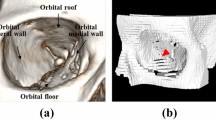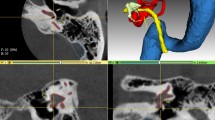Abstract
Purpose
Orbital wall segmentation is critical for orbital measurement and reconstruction. However, the orbital floor and medial wall are made up of thin walls (TW) with low gradient values, making it difficult to segment the blurred areas of the CT images. Clinically, doctors have to manually repair the missing parts of TW, which is time-consuming and laborious.
Methods
To address these issues, this paper proposes an automatic orbital wall segmentation method based on TW region supervision using a multi-scale feature search network. First of all, in the encoding branch, the densely connected atrous spatial pyramid pooling based on the residual connection is adopted to achieve a multi-scale feature search. Then, for feature enhancement, multi-scale up-sampling and residual connection are applied to perform skip connection of features in multi-scale convolution. Finally, we explore a strategy for improving the loss function based on the TW region supervision, which effectively increases the TW region segmentation accuracy.
Results
The test results show that the proposed network performs well in terms of automatic segmentation. For the whole orbital wall region, the Dice coefficient (Dice) of segmentation accuracy reaches 96.086 ± 1.049%, the Intersection over Union (IOU) reaches 92.486 ± 1.924%, and the 95% Hausdorff distance (HD) reaches 0.509 ± 0.166 mm. For the TW region, the Dice reaches 91.470 ± 1.739%, the IOU reaches 84.327 ± 2.938%, and the 95% HD reaches 0.481 ± 0.082 mm. Compared with other segmentation networks, the proposed network improves the segmentation accuracy while filling the missing parts in the TW region.
Conclusion
In the proposed network, the average segmentation time of each orbital wall is only 4.05 s, obviously improving the segmentation efficiency of doctors. In the future, it may have a practical significance in clinical applications such as preoperative planning for orbital reconstruction, orbital modeling, orbital implant design, and so on.







Similar content being viewed by others
References
Rossin EJ, Szypko C, Giese I, Hall N, Gardiner MF, Lorch A (2021) Factors associated with increased risk of serious ocular injury in the setting of orbital fracture. JAMA Ophthalmol 139(1):77–83
Chepurnyi Y, Chernohorskyi D, Prykhodko D, Poutala A, Kolchak A (2020) Reliability of orbital volume measurements based on computed tomography segmentation: validation of different algorithms in orbital trauma patients. J Craniomaxillofac Surg 48:574–581
Wildea F, Krauß O, Sakkas A, Mascha F, Pietzka S, Schramm A (2019) Custom wave-shaped CAD/CAM orbital wall implants for the management of post-enucleation socket syndrome. J Craniomaxillofac Surg 47:1398–1405
Kim MJ, Lee MJ, Jeong WS, Hong H, Choi JW (2020) Three-dimensional computer modeling of standard orbital mean shape in Asians. J Plast Reconstr Aesthet Surg 73(3):548–555
Hsung T, Lo J, Chong M, Goto TK, Cheung L (2018) Orbit segmentation by surface reconstruction with automatic sliced vertex screening. IEEE Trans Biomed Eng 64(4):828–838
Taghizadeh E, Terrier A, Becce F, Farron A, Büchler P (2019) Automated CT bone segmentation using statistical shape modelling and local template matching. Comput Methods Biomech Biomed Engin 22(16):1303–1310
Kim H, Son T, Lee J, Kim HA, Cho H, Jeong WS, Choi JW, Kim Y (2019) Three-dimensional orbital wall modeling using paranasal sinus segmentation. J Craniomaxillofac Surg 47:959–967
Xu J, Zeng B, Egger J, Wang C, Smedby Ö, Jiang X, Chen X (2022) A review on AI-based medical image computing in head and neck surgery. Phys Med Biol 67:17TR01
Xu J, Jing M, Wang S, Yang C, Chen X (2019) A review of medical image detection for cancers in digestive system based on artificial intelligence. Expert Rev Med Devices 16(10):877–889
Lee M J, Hong H, Shim K W, Park S (2019) MGB-NET: orbital bone segmentation from head and neck CT images using multi-graylevel-bone convolutional networks. In: Proceedings of IEEE 16th international symposium on biomedical imaging (ISBI). IEEE, pp 692–695
Ronneberger O, Fischer P, Brox T (2015) U-Net: convolutional networks for biomedical image segmentation. In: Proceedings of the international conference on medical image computing and computer-assisted intervention, Springer, Cham, pp 234–241
Hamwood J, Schmutz B, Collins MJ, Allenby MC, Alonso-Caneiro D (2021) A deep learning method for automatic segmentation of the bony orbit in MRI and CT images. Sci Rep 11(1):13693
Li Z, Chen K, Yang J, Pan L, Wang Z, Yang P, Wu S, Li J (2022) Deep learning-based CT radiomics for feature representation and analysis of aging characteristics of Asian bony Orbit. J Craniofac Surg 33(1):312–318
Xu J, Wang S, Zhou Z, Liu J, Jiang X, Chen X (2020) Automatic CT image segmentation of maxillary sinus based on VGG network and improved V-Net. Int J Comput Assist Radiol Surg 15:1457–1465
Milletari F, Navab N, Ahmadi SA (2016) V-Net: fully convolutional neural networks for volumetric medical image segmentation. In: Proceedings of the IEEE fourth international conference on 3D vision, pp 565–571
Wu Y, He K. Group normalization (2020) Int J Comput Vis 128(3):742–55
Chen L, Papandreou G, Kokkinos L, Murphy K, Yuille AL (2018) DeepLab: Semantic image segmentation with deep convolutional nets, atrous convolution, and fully connected CRFs. IEEE Trans Pattern Anal Mach Intell 40(4):834–848
Yong M, Yu K, Zhang C, Li Z, Yang K (2018) Denseaspp for semantic segmentation in street scenes. In: Proceedings of the IEEE conference on computer vision and pattern recognition (CVPR), pp 3684–3692
Xu J, Liu J, Zhang D, Zhou Z, Jiang X, Zhang C, Chen X (2021) Automatic mandible segmentation from CT image using 3D fully convolutional neural network based on DenseASPP and attention gates. Int J Comput Assist Radiol Surg 16:1785–1794
Xu J, Liu J, Zhang D, Zhou Z, Zhang C, Chen X (2021) A 3D segmentation network of mandible from CT scan with combination of multiple convolutional modules and edge supervision in mandibular reconstruction. Comput Biol Med 138:104925
Huang H, Lin L, Tong R, Hu H, Zhang Q, Iwamoto Y, Han X, Chen Y, Wu J (2020) UNet 3+: A full-scale connected UNet for medical image segmentation. In: Proceedings of the IEEE international conference on acoustics, speech and signal processing (ICASSP), pp1055–1059
Schlemper J, Oktay O, Schaap M, Heinrich M, Kainz B, Glocker B, Rueckert D (2019) Attention gated networks: learning to leverage salient regions in medical images. Med Image Anal 53:197–207
Acknowledgements
This work was supported by Natural Science Foundation of China (81971709; M-0019; 82011530141), the Foundation of Science and Technology Commission of Shanghai Municipality (20490740700), Shanghai Jiao Tong University Foundation on Medical and Technological Joint Science Research (YG2021ZD21; YG2021QN72; YG2022QN056; YG2023ZD15; YG2023ZD19), SJTU Global Strategic Partnership Fund (2021 SJTU-HUJI, 2023 SJTU-CORNELL), Cross disciplinary Research Fund of Shanghai Ninth People's Hospital, Shanghai Jiao Tong University School of Medicine (JYJC202115), and Translation Clinical R&D Project of Medical Robot of Shanghai Ninth People's Hospital, Shanghai Jiao Tong University School of Medicine (IMR-NPH202002). Shanghai Key Clinical Specialty, Shanghai Eye Disease Research Center (2022ZZ01003).
Author information
Authors and Affiliations
Corresponding authors
Ethics declarations
Conflict of interest
The authors declare that they have no conflict of interest.
Ethical approval
All procedures performed in studies involving human participants were in accordance with the ethical standards of the institutional and/or national research committee and with the 1964 Helsinki Declaration and its later amendments or comparable ethical standards.
Informed consent
There was no informed consent required for the work reported in this manuscript.
Additional information
Publisher's Note
Springer Nature remains neutral with regard to jurisdictional claims in published maps and institutional affiliations.
Rights and permissions
Springer Nature or its licensor (e.g. a society or other partner) holds exclusive rights to this article under a publishing agreement with the author(s) or other rightsholder(s); author self-archiving of the accepted manuscript version of this article is solely governed by the terms of such publishing agreement and applicable law.
About this article
Cite this article
Xu, J., Zhang, D., Wang, C. et al. Automatic segmentation of orbital wall from CT images via a thin wall region supervision-based multi-scale feature search network. Int J CARS 18, 2051–2062 (2023). https://doi.org/10.1007/s11548-023-02924-z
Received:
Accepted:
Published:
Issue Date:
DOI: https://doi.org/10.1007/s11548-023-02924-z




